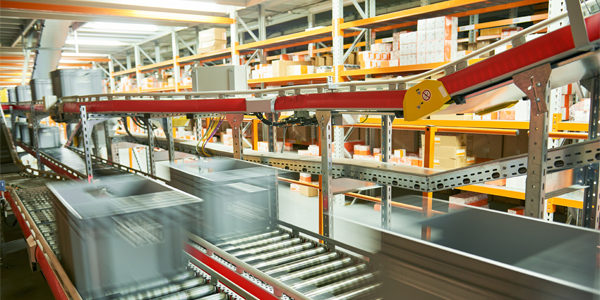Start me up

From a supply chain perspective, the 2018 holiday season was relatively quiet. While some retailers struggled with sales (most notably the department store chain Macy's), most made it through the holidays without any major breakdowns in service. Inventory was in stock, on-shelf availability was good, and e-commerce orders were delivered on time.
As retailers now turn the corner into 2019, they are looking to build on that success. But to do so, they will have to navigate a host of challenges, including the pressures created by omnichannel retailing, a shortage of labor, and an ongoing push to boost operating efficiency.
To find out how retailers are responding to these and other challenges, a team from Auburn University's Center for Supply Chain Innovation conducts a study among retail supply chain executives each year. The research is conducted in two parts. For the first phase of the study, a team led by the center's executive director, Brian Gibson, conducts in-depth interviews with about two-dozen senior supply chain executives from some of the top 100 retailers by sales (the vast majority work at companies with $2 billion or more in sales). This year, those interviews took place in December and January. The second phase is an online survey that Auburn conducts in conjunction with DC Velocity and the Retail Industry Leaders Association (RILA). The results of that survey, which is now under way, will form the basis for the annual State of the Retail Supply Chain Report, which will be published by the end of April, according to Gibson. (Last year's report can be found here.)
Although the results of the online survey were not available at press time, the executive interviews offer some important clues into where the retail industry is headed this year. What follows is a look at some of the findings.
RUNNING HOT
Many of the pressures and goals cited by retail executives during this year's interviews are not new. For instance, last year at this time, many of the executives Gibson spoke with identified better management of omnichannel commerce as a top priority. This year's interviews suggest that most have made good progress toward reaching that goal. "They are more comfortable that they have enough inventory allocated effectively and that they are doing a better job filling orders efficiently," Gibson says.
But that doesn't mean that retailers have omnichannel fulfillment completely figured out. Fulfillment of e-commerce orders remains expensive, and retailers are still trying to find the most cost-effective way to get product to customers, as they explore options like "buy online, pick up in store," or BOPIS. "They are still all striving for the perfect combination of where best to fill orders from and how to avoid a lot of split shipments," Gibson says. "There are still opportunities to enhance in-stock availability from the point closest to the last mile."
MAKE A GROWN MAN(AGER) CRY
These efforts to find that perfect combination, however, are happening in a tight labor market. While a 3.9-percent unemployment rate is great news for the general economy, it's enough to make distribution center (DC) managers cry.
That's because the better the employment picture gets, the harder it is for them to retain workers. In periods of low unemployment, people tend to leave distribution center jobs, which are often physically demanding and have less-than-desirable hours, for work in other industries.
"Retailers have had to get creative over the past year in order to overcome labor availability shortages," Gibson says.
According to Gibson, some of the strategies that companies have deployed in a bid to retain workers include:
- Raising pay to compete with the $15-an-hour wages that Amazon now pays its distribution center associates.
- Accelerating pay-scale escalation. For example, in the past, a company's policy might have been to start new employees at $12.50 per hour and then bump them up to $15.50 per hour after three years. Now, new employees may be earning $15.50 an hour after just 18 months.
- Expanding the kinds of benefits offered to full-time employees.
- Providing full benefits for part-time associates who work at least 30 hours a week.
- Using software apps to give DC workers more control over their work schedule. These apps allow workers to see what hours they've been assigned, trade shifts, and volunteer for extra shifts or overtime.
- Investing in automated equipment or assistive technology, such as mobile carts and robotic arms, to make DC work less physically demanding.
People issues are not just limited to the hourly work force, Gibson says. Supply chain executives are also struggling to retain and develop future leaders in an environment where young professionals often change jobs after only two years. Adding to the challenge, they're discovering that candidates with the skills they're looking for aren't easy to find. "They need people who understand supply chain management, are comfortable in the analytics space, and can lead the charge toward automation, omnichannel excellence, and supply chain digitization," Gibson says.
DOUBLE SPEED
While labor may be tight, the pressure to quickly make and execute on supply chain decisions has only intensified. In response, retailers are increasingly turning to "disruptive" technologies that will allow them to respond faster, Gibson says.
Three areas that are attracting particular attention are robotics, supply chain digitization, and artificial intelligence (AI) and predictive analytics. What follows is a look at some trends in these areas:
Robotics: Retailers are showing unprecedented interest in robotic technologies, but when it comes to the types of technologies they're investigating, the choices are all over the map. On one end are large grocery retailers, such as Kroger, that are looking at automating their entire facility with equipment like automated storage and retrieval systems (AS/RS). On the other end are smaller companies that are focusing on automated pallet jacks or carts that travel alongside the worker as he or she picks orders. Companies are also interested in robotic arms that can grab and lift heavy cartons or individual items.
Digitization: At the same time they're exploring robotics, retailers are also pursuing initiatives aimed at "digitizing" the supply chain, according to Gibson. For many of them, this means establishing data pools or repositories that contain detailed information on products, inventory levels, costs, transactions, and the like. This data pool will provide "a single version of the truth" not just for the supply chain function but for other functions as well. The hope is that this digitization will improve supply chain visibility and transparency, which will in turn lead to better inventory allocation and customer service.
Artificial intelligence and predictive analytics: As retailers work to create a common pool of supply chain data, they're also hoping that advances in AI and predictive analytics can help them use that information more effectively. What these companies ultimately want, according to Gibson, is the ability to leverage analytics programs and AI to provide managers with "actionable information," thereby reducing the amount of time supply chain managers spend "crunching data and staring at spreadsheets."
For example, companies could use AI to assess the accuracy of the forecasting models they've used in the past and make suggestions about which models they should use for specific situations—say, peak versus nonpeak seasons. Similarly, predictive analytics could be used to create much more focused, specific inventory allocation suggestions that could be customized to an individual store.
Not all disruptive technologies are garnering the same amount of interest from retailers, however. According to Gibson, the sense among most of the supply chain executives he's interviewed is that technologies like blockchain and the Internet of Things (IoT) are still way out on the horizon. "For the most part, they are finding that blockchain is still at the theoretical discussion stage," he says.
With the exception of blockchain and IoT, however, retailers' interest in disruptive technology is more than just talk, according to Gibson. He says retail supply chain leaders are finding it easier to obtain approval for investments in automated equipment and technology than they did in the past. While companies once evaluated spending requests strictly on the basis of cost, payback period, and return on investment (ROI), they appear to be backing off from those rigid guidelines. Today, they're more willing to look past those metrics in cases where the proposed technologies have high potential to improve service quality, boost inventory accuracy, or help the company better meet deadlines and delivery dates, Gibson says.
This willingness to invest in their supply chains is decidedly good news. Without that new technology (and a commitment to retaining and developing their talent), retailers will be hard-pressed to keep up with the rapidly evolving omnichannel commerce world and compete with the likes of Amazon. And in spite of this past holiday season's success, those that fail to keep up could next year find themselves in the same plight as Toys "R" Us, Sears, and other retailers that didn't adapt to the times.

Copyright ©2024. All Rights ReservedDesign, CMS, Hosting & Web Development :: ePublishing